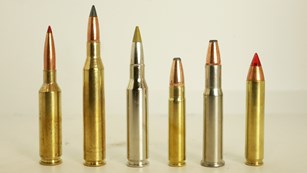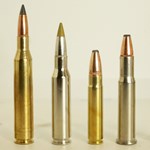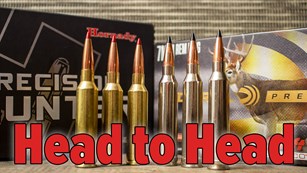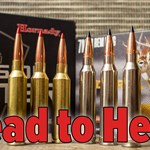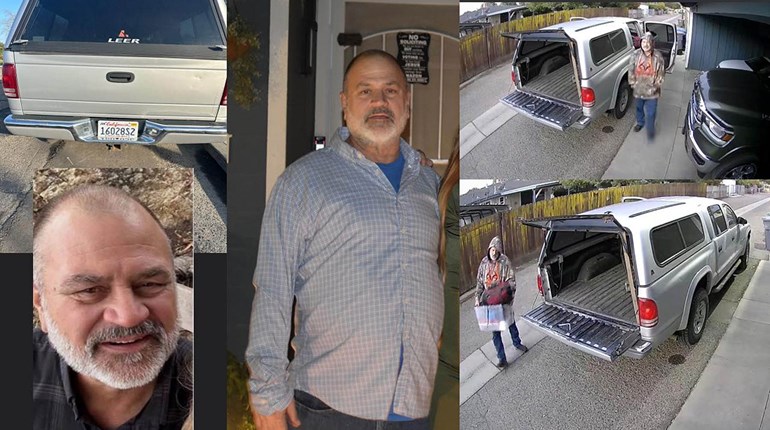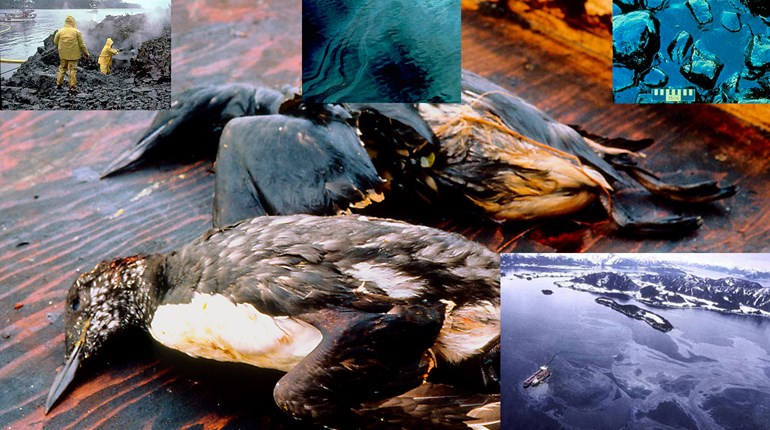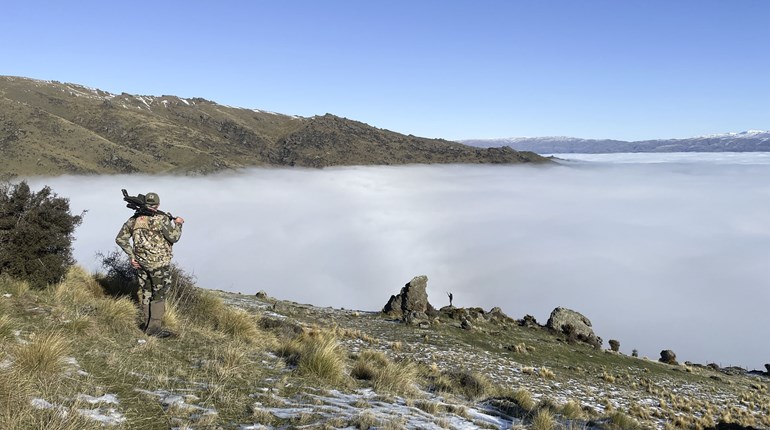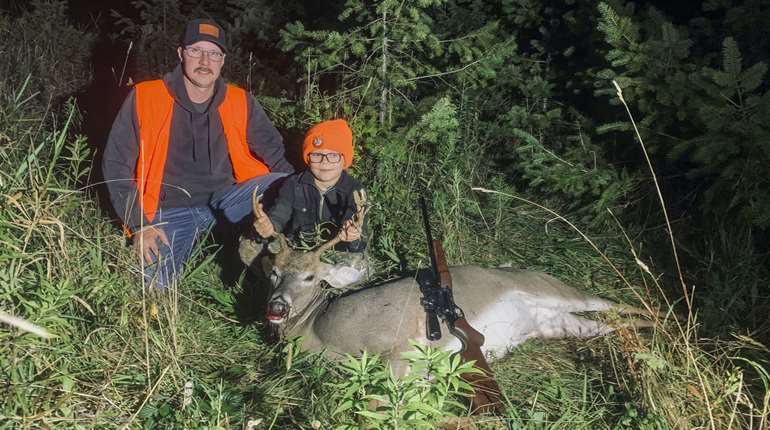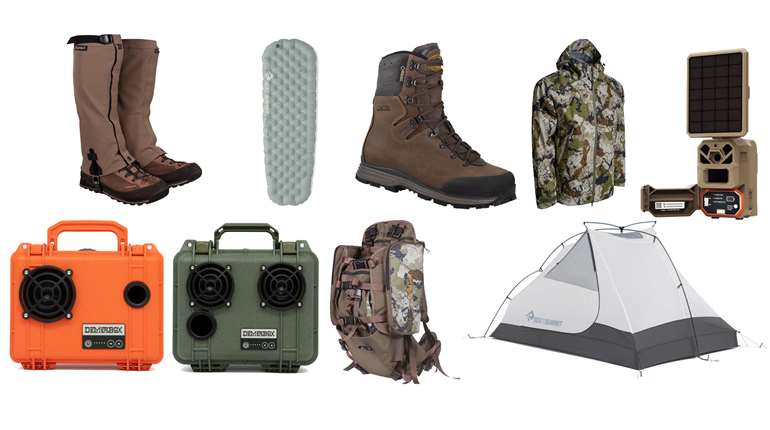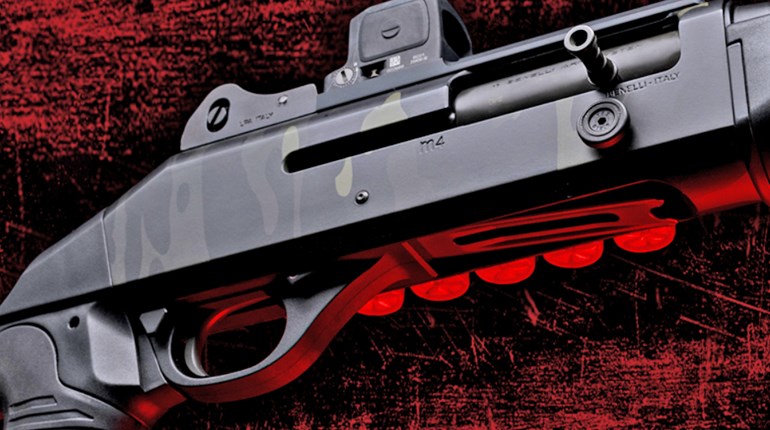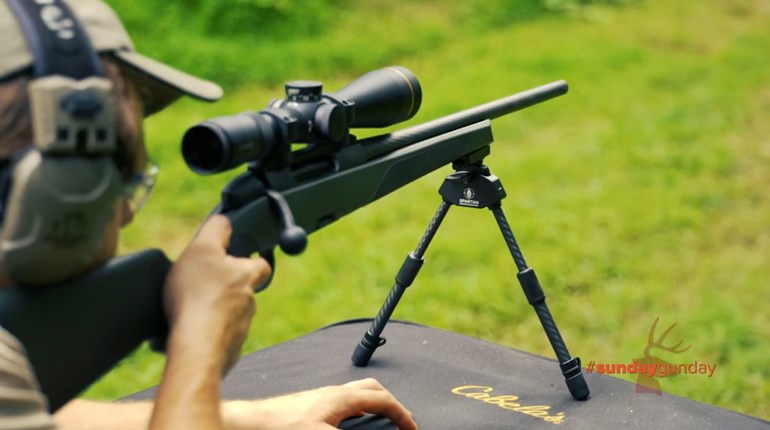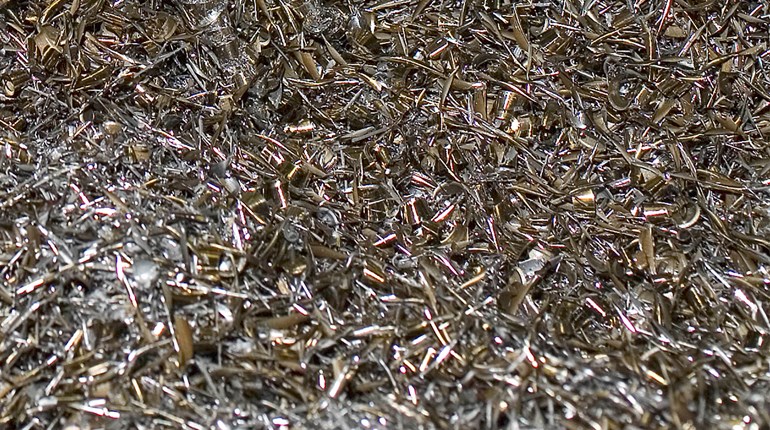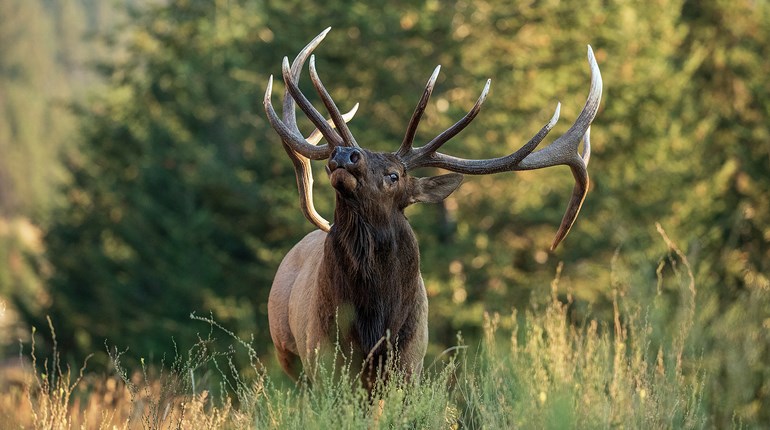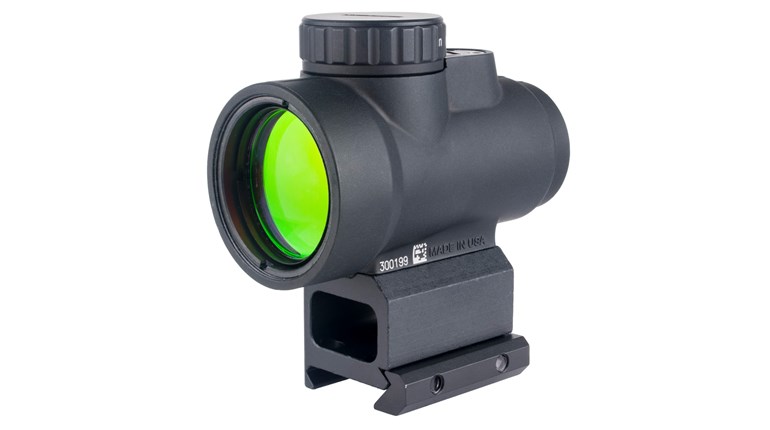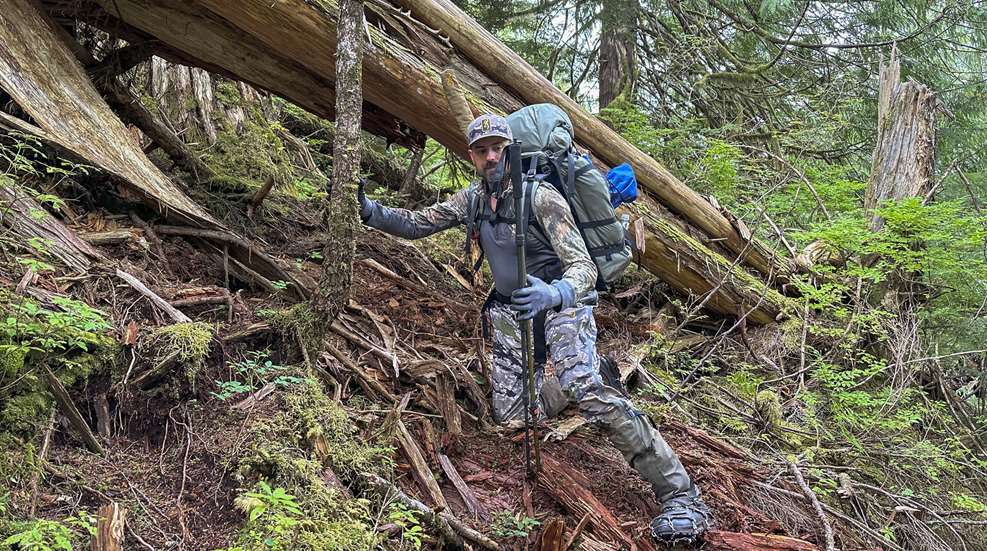
Fog lay heavy upon the land, shrouding everything in rolling mists of gray. The trees dripped, my hat dripped, the whole world around me dripped water. I’d come here to hunt Sitka blacktail deer high in the subalpine of southeast Alaska—a new experience for this son of wind and sand. Where I come from rain is a rare and blessed event, bringing life to the desert and joy to the hearts of its dwellers. Looking down, I watched rainwater flowing through the tundra-like vegetation beneath my LaCrosse boots. It would seem that sunshine here was almost as rare as rain is in my desert.
The weather forecast had proffered a possible clearing the next afternoon and the following morning. A 24-hour hunting window was all that my hunting buddy Nathan and I could anticipate, an evening and a morning in which to find and take a buck each. For this we had flown across North America, rented a truck, rode a ferry then backpacked up the most brutal mountainside of my experience. We made it to the top before full darkness set in, but only just. Now we each needed to find a place to set our lightweight tents. Dry was not even a possibility, so we simply searched for places free of standing or flowing water.
Profoundly grateful for the waterproof floor on my Stone Glacier tent, I tucked it into a semi-level spot aside a small open saddle. Stunted trees reached their mossy trunks skyward through the mist, and a small vantage point across the saddle would offer a good view of an open mountainside, should the fog ever clear. It was enough; I tucked my rifle inside my tent, stowed my pack under the rain fly and struggled out of my raingear. I was hungry, and a hot freeze-dried meal sounded pretty good. I could hear Nathan settling into his new digs a few paces away. Darkness became as thick as the mist as I flicked my lighter and lit my MSR PocketRocket stove. Tomorrow, weather gods willing, we would hunt.

Deer of a Magical Realm
The subalpine of southeast Alaska is a unique place, a land between lands. High above the seaboard and the dense forest belt that follows, yet lower than the open alpine, the subalpine is that area where meadows break the armor of the forest. Wandering and intermittent, the meadows mingle with stunted trees that reach gnarled limbs toward the gray light of coastal Alaska skies. When the skies open and the sun shines through, the subalpine becomes a land of impossible beauty, with mountains, forest, lakes and ocean reaching as far as the eye can see. Blink, and you might feel like some ethereal Robin Hood in a magic realm, or a primitive Viking gazing across newly discovered lands.
The subalpine is ideal habitat for Sitka blacktail deer during the summer and early fall months, providing everything they need to thrive. These small deer are a subspecies of the larger mule deer, and close cousins of the Columbian blacktail deer. Their faces are a bit shorter than the other members of their family. Antlers are typically small as well, and often sport eye-catching mass and a rich brown or reddish color. A mature buck will usually have a rack with three points and a brow tine on each side. A truly great buck will sport double forks and a brow tine on each side like a mature muley. Minimum score requirements to qualify for the all-time Boone & Crockett book are 108 for typical and 118 for non-typical.
Sitka deer usually weigh between 80 and 120 pounds during the fall hunting season, though significantly heavier bucks have been reported. During midsummer and early fall hunts deer wear a reddish-gold-brown coat that really stands out when the sun hits them. As winter arrives their color changes to a dark gray-brown, which blends well with the heavy forest regions they favor during this season.
Their rut occurs mostly in November, and during that time Sitkas can be the most call-able deer in North America. Local hunters often prefer to hunt this time of year rather than the early season, and use a shrill, whistling call that mimics the sound of a Sitka blacktail. Bucks and does alike will come to the call, and the action can be fast and exciting. Depending on location, Sitka deer can be hunted from late summer to mid winter, and in many areas a hunter can harvest three or four bucks per year. The meat from Sitka deer is delicious, and forms an important part of the locals’ diet.

Crampons and Devil’s Club
Climbing to the subalpine was, as I mentioned earlier, the most brutal climb I’ve made. There are areas where you can drive to the subalpine, but those places are usually hunted hard and lack a population of mature bucks. Nathan and I wanted to hunt a place where the deer were mostly unpressured. My friend Sam—a local—recommended an area, with the cautionary advice that the pack in was really, really hard. I took this word to heart, but was only intrigued the more by it. Sam advised that we wear boots with calks (spikes in the soles), or at least wear crampons over our regular boots. That may have been the most important piece of advice we received.
In Southeast Alaska everything is wet all the time; rocks, downed logs, even the mountainside dirt is wet and slippery. Moss grows heavily on most surfaces, making them even more slippery. The locals universally wear XtraTuf boots, often with factory-installed steel calks in the soles. I wanted a pair, but was unable to find them in my size. But I had a backup plan: my beloved LaCrosse Ursa boots with Uelfbaby crampons strapped over the soles. This system worked remarkably well; I was able to scramble up steep slopes, walk atop mossy logs and step on slippery boulders with nary a slip. I don’t believe the climb we made to the subalpine would have been possible without spikes or crampons—the terrain and vegetation is simply too treacherous.
There were other challenging obstacles throughout the climb: massive downed trees that we had to climb over or under, areas of deadfall that resembled a giant’s collection of Lincoln logs dumped in a heap during some fit of rage, and creeks rushing downward through boulder-strewn slopes. But Sam had particularly warned us about one really nasty adversary, a plant called devil’s club. I had never encountered this stuff from hell before, but I can attest it’s aptly named. Flourishing from ground level to above head height and in dense, gnarled thickets, the stuff is stiff and unyielding and sports thousands of spines from hades. At times we had to pass through those thickets. The devil’s club would trip and entangle our feet, snag our packs, clothing, trekking poles, and do its evil best to upend us into its sea of thorns. We had to purposefully never grab or clutch at it to arrest a fall, because grabbing a devil’s club would be akin to slapping a fast-moving meat grinder. When I next hunt Southeast Alaska I plan to carry a sharp machete and wreak vengeance on any devil’s club that stands in my path.
Sunshine
Dawn came dreary and damp, the land engulfed in fog. Visibility was just better than gazing through pea soup, so Nathan and I made a bit of breakfast, tidied up our camps, and peered into the mist, wishing for a glimpse of distance. I had made a colossal mistake when packing, unintentionally leaving my warm coat hung up to dry. It still hung there, safe in the cabin far below. I was thankful I had two sets of thermals in addition to my shirt and raingear. I wore them all, and while often chilly I never became truly cold. Morning drew on then the clouds around us began to break up and blow out. Emerging mountain and ridge tops inspired us, so we shouldered our packs and picked up our rifles. It was time to hunt.
Climbing a steep hill behind our camp, we stalked our way through subalpine meadows and stunted timber. It wasn’t long before we spotted our first blacktail, a doe that observed us curiously from atop a brushy mound. Our hearts pumping, we studied the area around her for a buck. Nothing showed, so after she snuck away we continued hunting. The ridge top was a delightful mess of twisted hollows, mounds and pockets. Each held promise of a big buck, so we wandered our way northward, hopeful at every new rise and hollow. Twice we jumped deer, both does. The hours rolled by, and as we reached a far point of the ridge we spotted something white down in a ridge-side hollow. Curious, we made our way toward the spot. A weathered white hard hat lay where it had fallen from a large boulder, and a set of weathered, steel-calked logging boots rested atop the boulder. A small iron plaque was inlaid on the rock as well, giving tribute to a logger, a man who loved to hunt this region, and who died too young. A somber mood held sway over the place. Self-consciously I picked up the white hard hat and placed it back atop the boulder with the boots, feeling the hunter would have liked it that way. Turning, we made our way back to the ridge top and deployed our binoculars.
The little monument was the only sign of mankind we saw on the subalpine ridge top. The sun was low in the west as we hunted back to camp and set up on our little vantage point across the saddle. For 45 minutes we glassed the distant hillside intently, without turning up a single deer. Darkness fell, and, disappointed, we made our way back to camp. Tomorrow would be another day—or at least a half day, before the weather socked back in. But the fact that we hadn’t seen many deer—and not a single buck—had us worried. Peeling away my damp clothing, I climbed into my sleeping bag and opened a package of Mountain House. At least it wasn’t raining tonight.
The next-morning sunrise over Southeast Alaska was spectacular, but we were too busy spotting deer to pay it much attention. To our great delight deer were everywhere across the distant hillside. Keeping track of them in the patchy timber and erratic meadows was difficult. I got a glimpse of a big buck in a small meadow only 200 yards away, but was unable to manufacture a shot through overhanging limbs and timber. Several small bucks fed and meandered with double handfuls of does, scattered all over the hillside. We caught a brief look at another good buck in a fold nearly at the top of the hillside, but lost him just as quickly.
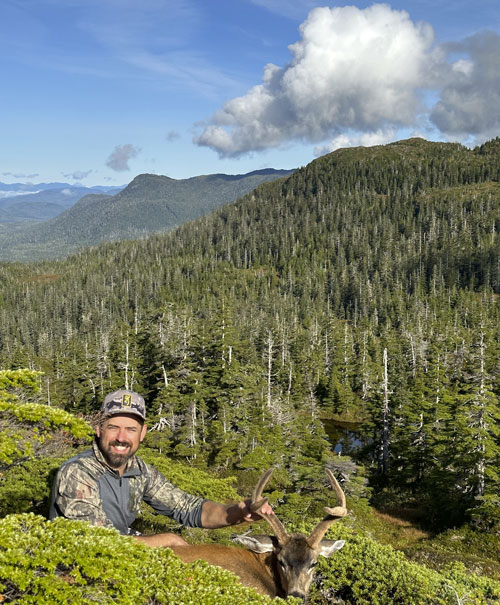
The morning drew on, and as sunshine brightened the day deer shown like red-gold beacons across the green hillside. Trying to keep track of the bucks, we hoped a big one would show. It seemed the general trend of the deer was to feed slowly upward, eventually disappearing over the ridge. Then from out of nowhere the big buck I’d tried to shoot earlier appeared, glowing brightly on the hillside about halfway to the top. Chambering a round, I settled in behind my rifle. The range was 392 yards, and I dialed my scope appropriately. On my belly atop a wet tundra hummock, with a Javelin Pro bipod supporting the front of my rifle, I was steady as a rock.
A few twigs obstructed my bullet’s path to the vitals, so I settled in to wait. Chances were good that the buck would eventually move into an opening, giving me an opportunity for a clean shot. Nathan filmed the buck via my spotting scope and Phone Skope attachment system. Watching and waiting, we stayed ready as the deer fed his way upward, his coat glowing in the sunlight.
Long minutes ticked by, and I began to grow cold from the chill air and wet, cold ground beneath me. Adrenaline set in too, and I had to fight hard to keep from shaking. Several times an opportunity seemed eminent, but then the buck would turn into the thick again. Working to stay relaxed I waited, trying to ascertain through my riflescope whether the buck had small rear forks on his antlers. I could see something; looked like he was a least bladed on those rear tines. And then it happened; the buck fed out from behind a gnarly tree, finally showing me a clear path for a shot. I settled my crosshairs on the vitals, calmed my shaking nerves and pressed the trigger.
Nearly 400 yards away the 162-grain Copper Impact bullet passed through vitals and bone then buried in the tundra beyond. The buck jumped and kicked, flashing down the hillside and out of sight. I was confident in my shot so Nathan and I focused on looking for another mature buck as the remaining deer snuck out, leaving the hillside empty. No other big bucks showed, so we shouldered our packs and headed across to recover my blacktail.
We’d only gone partway when Nathan let out an urgent hiss. Looking up, I saw what he’d spotted, a good buck standing atop the ridge watching us. In less time than it takes to tell Nathan dropped to the ground, rested the 6.8 Western across a pack and dumped the 315-yard-distant buck in its tracks. Unbelieving, we celebrated then hustled up the hillside to see our bucks. Somehow we’d pulled it off, each taking a mature Sitka blacktail during our brief respite from fog and rain.
We took photos, quartered our deer and packed them back to camp. The rest of the day we spent processing our meat into freezer bags, trimmed, tidy and ready to go into the freezer. This helped reduced the weight we would carry down that hellacious mountainside. Tired but jubilant, we made dinner and turned in as the sky began to lower and darken. If we could survive the pack off that brutal slope tomorrow all would be well.

Epilogue
Survive we did, though that descent was worthy of a place in my memoirs, should I ever write any. Fighting massive deadfall jungles, devil’s club thickets and 80-pound packs, we made our way off the mountain. I’ve never been more pleased to spot the truck, happy that my limbs and body were unbroken. Peeling the crampons from my boots, I gave them a mental kiss of gratitude and tossed them on the floorboard. Heaving our packs into the bed of the truck, we staggered forward and gratefully sagged into our truck seats. Nathan fired up the motor and we pulled onto the gravel road. It would be a long trip home, but we had conquered the mountain and hunted our Sitka blacktails the right way, on their own turf, high in the subalpine territory of Southeast Alaska.

Guns and Ammo
For this adventure I chose to hunt with 162-grain Winchester Copper Impact ammo in 6.8 Western. I wanted a round that would perform well regardless if my shot opportunity came at 30 yards in heavy timber or 500 yards across a subalpine swale. The 6.8 Western checked all my boxes; it’s accurate, aerodynamic and loaded with the solid copper projectile it penetrates like a runaway U-boat. Both of our deer fell to single, well-placed shots. Performance, as expected, was stellar. winchester.com
My Browning X-Bolt Western Hunter rifle was slightly less suited for the job, simply because it sports a blued steel barrel and action that’s susceptible to rusting in the wet, salty environment of Southeast Alaska. A stainless-steel model X-Bolt would have been a better option, but my rifle shoots very well and I don’t have a stainless model. With a bit of extra care and oil the rifle came through like a champ. browning.com




